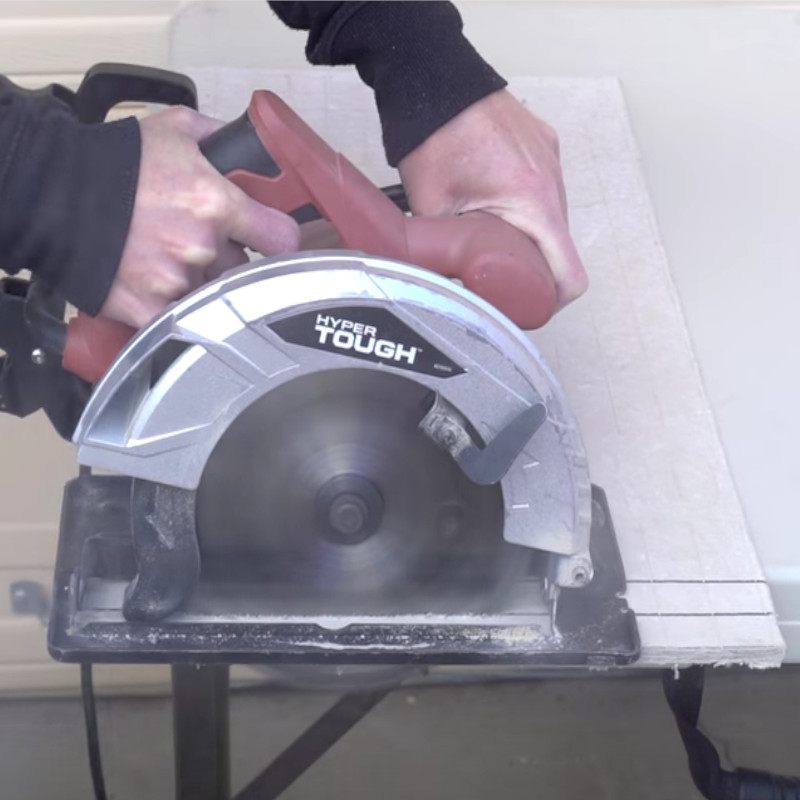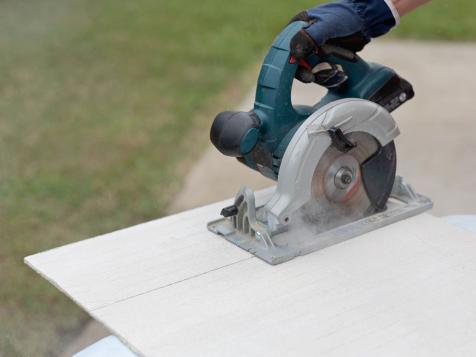Looking to cut hardiebacker with a circular saw? Wondering if it’s the right tool for the job? You’re in the right place! In this article, we’ll explore whether a circular saw is suitable for cutting hardiebacker and provide you with all the information you need to make an informed decision. So, let’s dive in and find out the answer!
When it comes to cutting hardiebacker, many people ask if they can use a circular saw. Well, the good news is that yes, you can! A circular saw can be a convenient and efficient tool for cutting hardiebacker. However, there are a few considerations and precautions you need to keep in mind to ensure a successful and safe cutting experience.
So, if you’re thinking about tackling a project that involves cutting hardiebacker, stay tuned. We’ll cover everything you need to know about using a circular saw for this task, including the right blade to use, safety precautions, and some handy tips to make your cutting experience a breeze. Are you ready to become an expert in cutting hardiebacker with a circular saw? Let’s get started!
- Measure and mark the desired cutting line on the Hardiebacker board.
- Place a straightedge along the marked line to guide your circular saw.
- Put on safety goggles and a dust mask.
- Set the blade depth on your circular saw to the thickness of the Hardiebacker board.
- Cut along the marked line, keeping the saw steady and applying gentle pressure.
Follow these steps to cut Hardiebacker with ease and precision using your circular saw.

Can I Cut Hardiebacker with a Circular Saw?
When it comes to cutting Hardiebacker, a commonly used cement board for tiling projects, many DIY enthusiasts wonder if using a circular saw is a viable option. In this article, we will delve into the details of cutting Hardiebacker with a circular saw, exploring the benefits, methods, and potential challenges associated with this approach. Whether you’re a seasoned professional or a novice DIYer, this article will provide you with the information you need to make an informed decision about using a circular saw for cutting Hardiebacker.
What is Hardiebacker?
Before we dive into the specifics of cutting Hardiebacker with a circular saw, let’s first understand what Hardiebacker is. Hardiebacker, also known as James Hardie Cement Board, is a durable, water-resistant cement-based backer board that is commonly used as a substrate for tile and stone installations. It is renowned for its strength, stability, and ability to withstand moisture, making it an ideal choice for bathrooms, kitchens, and other areas prone to high humidity. With its excellent properties, Hardiebacker provides a reliable and sturdy foundation for tiles, ensuring a long-lasting and professional finish.
The Benefits of Cutting Hardiebacker with a Circular Saw
When it comes to cutting Hardiebacker, there are several benefits to using a circular saw:
- Precision: Circular saws offer a high level of precision, allowing for clean and accurate cuts.
- Speed: Circular saws are powerful tools that can cut through Hardiebacker quickly, saving you time and effort.
- Versatility: Circular saws can handle a variety of cutting tasks, making them a versatile tool in any workshop.
With these benefits in mind, it’s no wonder that many professionals and DIY enthusiasts prefer using a circular saw for cutting Hardiebacker.
Methods for Cutting Hardiebacker with a Circular Saw
Now that we understand the benefits of using a circular saw, let’s explore the different methods you can employ to cut Hardiebacker:
- Measure and mark the cutting line on the Hardiebacker board.
- Secure the board onto a stable work surface using clamps or a sturdy support.
- Choose a carbide-tipped blade specifically designed for cutting cement board.
By following these steps, you can achieve precise and clean cuts on Hardiebacker using a circular saw. However, it’s important to note that working with cement board can generate a significant amount of dust, so wearing appropriate personal protective equipment, such as a dust mask and safety glasses, is crucial.
Challenges and Tips for Cutting Hardiebacker with a Circular Saw
While cutting Hardiebacker with a circular saw offers many advantages, it’s essential to be aware of the potential challenges that may arise:
- Dust: Cutting Hardiebacker produces dust, which can be harmful if inhaled. Always work in a well-ventilated area and wear a dust mask to protect yourself.
- Blade Wear: Cutting cement board can wear down the blade of your circular saw more quickly than other materials. Keep spare blades on hand to ensure you can maintain optimal performance.
- Control: The power and speed of a circular saw can make it challenging to maintain control while cutting Hardiebacker. Take your time and use steady, controlled movements to ensure clean and accurate cuts.
By being aware of these challenges and following the provided tips, you can overcome any difficulties and achieve professional results when cutting Hardiebacker with your circular saw.
Additional Tips for Working with Hardiebacker
While cutting Hardiebacker is a crucial step in any tiling project, there are a few additional tips to keep in mind when working with this durable cement board:
1. Safety First:
Always prioritize safety when working with Hardiebacker. Wear appropriate personal protective equipment, such as gloves, safety glasses, and a dust mask, to protect yourself from potential hazards.
2. Use the Right Tools:
In addition to a circular saw, make sure you have the necessary tools to handle Hardiebacker installation. A carbide-tipped scoring knife, carbide-tipped jigsaw, and carbide-tipped hole saws are just a few examples of tools that can make your job easier and more efficient.
3. Plan and Measure Carefully:
Prior to cutting Hardiebacker, take the time to plan and measure your project carefully. Accurate measurements will ensure your cuts are precise, minimizing waste and saving you time and money.
4. Secure the Board:
When cutting or installing Hardiebacker, it’s important to secure the board properly. Use clamps or supports to prevent movement and ensure stability, allowing for more accurate cuts and a higher-quality installation.
5. Minimize Dust:
Hardiebacker dust can be harmful when inhaled, so take precautions to minimize dust production. Consider using a dust collection system or working near a window or open door to improve ventilation and reduce the amount of dust in the air.
Conclusion
Using a circular saw to cut Hardiebacker is a popular choice among professionals and DIYers alike due to its precision, speed, and versatility. By following the recommended methods and taking appropriate safety precautions, you can achieve clean and accurate cuts on Hardiebacker, setting the stage for a successful tiling project. Remember to prioritize safety, use the right tools, plan and measure carefully, secure the board, and minimize dust to ensure a smooth and efficient installation. With these tips in mind, you’ll be well-equipped to tackle your next tiling project using a circular saw to cut Hardiebacker with confidence.
Can I Cut Hardiebacker with a Circular Saw?
- Yes, it is possible to cut Hardiebacker with a circular saw.
- Make sure to use a diamond-tipped or carbide-tipped blade for the best results.
- Wear safety goggles, gloves, and a dust mask to protect yourself from flying debris and dust.
- Score the Hardiebacker first with a utility knife to create a guideline for the circular saw.
- Go slow and steady when cutting to prevent any chipping or cracking of the Hardiebacker.
Frequently Asked Questions
Are you wondering if you can use a circular saw to cut hardiebacker? Look no further! Here are some common questions and answers to guide you through the process with ease.
1. Can I cut hardiebacker with a circular saw?
Yes, you can cut hardiebacker with a circular saw. Hardiebacker, also known as cement board, is a durable material often used as an underlayment for tile installation. Its strong composition makes it a bit more challenging to cut compared to other materials, but a circular saw can get the job done.
Before cutting, make sure you have the appropriate blade for the task. Look for a diamond or carbide-tipped blade specifically designed for cutting through cement board. This type of blade can handle the tough nature of hardiebacker and provide clean, precise cuts.
2. Is it safe to cut hardiebacker with a circular saw?
When done correctly, cutting hardiebacker with a circular saw is safe. However, it’s important to take proper safety precautions to minimize any risks. Wear safety goggles to protect your eyes from any flying debris and a dust mask to prevent inhaling any dust particles released during the cutting process.
Additionally, always make sure to follow the manufacturer’s instructions for both the circular saw and the hardiebacker itself. Operate the saw at the recommended speed, and use steady, controlled movements to guide the saw through the material. By following these guidelines, you can ensure safe and successful cutting.
3. What type of blade should I use to cut hardiebacker with a circular saw?
When cutting hardiebacker with a circular saw, it’s essential to use the right type of blade. Look for a blade with a diamond or carbide tip specifically designed for cutting through cement board. These blades are more durable and can withstand the tough nature of hardiebacker.
The diamond or carbide-tipped blade is specifically designed to handle the unique properties of hardiebacker and provide clean, precise cuts. Using a different type of blade, such as one for cutting wood or metal, may result in less efficient cuts and may even damage the blade or the board.
4. Are there any tips to make cutting hardiebacker with a circular saw easier?
Definitely! Here are a few tips to make cutting hardiebacker with a circular saw easier:
– Measure and mark the areas you need to cut accurately to ensure clean and precise cuts.
– Use a straight edge or a clamp guide to help maintain straight cuts and prevent the circular saw from drifting off course.
– Take your time and use a steady, controlled movement when guiding the saw through the hardiebacker. Rushing the process may result in uneven cuts or damage to the board.
– If possible, cut the hardiebacker outside to minimize dust and ensure proper ventilation. If cutting indoors, consider using a dust collection system or working near an open window for better airflow.
5. Should I use water to cut hardiebacker with a circular saw?
No, you should not use water to cut hardiebacker with a circular saw. Unlike other materials, such as tile, that require water for cooling and dust suppression during cutting, hardiebacker does not benefit from water usage.
In fact, introducing water to the cutting process can cause the hardiebacker to become too soft and muddy, potentially damaging the material and resulting in less precise cuts. Stick to using the appropriate carbide or diamond-tipped blade without water when cutting hardiebacker for the best results.

Summary
Cutting Hardiebacker with a circular saw is possible, but it can be challenging.
First, you need the right blade and safety gear. Remember to wear safety goggles and a dust mask.
Second, set the depth of the blade to prevent damage to your surface. This will help you achieve clean and precise cuts.
Lastly, be careful and take your time. Hardiebacker is a durable material that requires patience and precision to cut properly.
Overall, cutting Hardiebacker with a circular saw is possible with the right tools and precautions.
